Private issues (Ahualulco - Etzatlán)
Ahualulco
Ahualulco el Mercado is 75 kilometres west of Guadalajara.
Ricardo Uribe
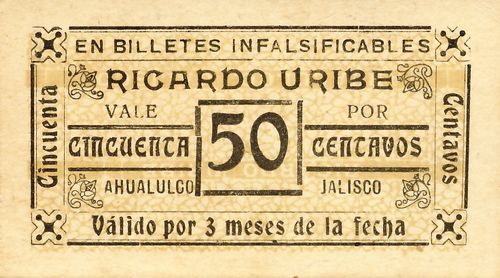 M2367 50c Ricardo Uribe
M2367 50c Ricardo Uribe
Ricardo Uribe was no doubt related to Rafaela Gómez de Uribe, who ran the hacienda "San Ignacio" in Ahualulco.
Only a 50c is known of a series of notes valid for three months from the date of issue and redeemable in infalsificables. These were printed by J. M. Iguíniz.
Molino de Nixtamal
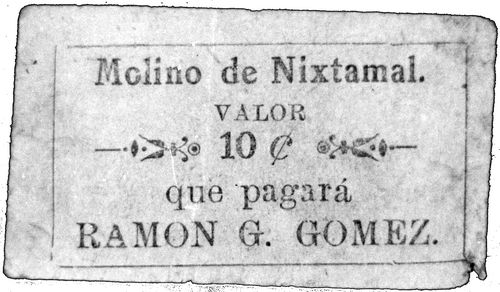 M2370 10c Ramón G. Gómez
M2370 10c Ramón G. Gómez
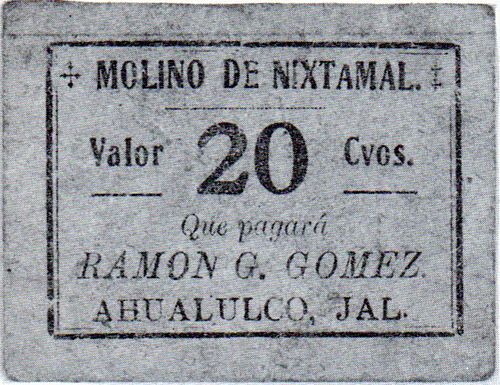 M2371 20c Ramón G. Gómez
M2371 20c Ramón G. Gómez
A series of at least three values (5c[image needed], 10c, and 25c) issued by this corn-mill, owned by Ramón G. Gómez, with various dates in 1915 (the 10c is 4 August and the 20c is 14 October). They are handstamped on the reverse 'RAMON G. GOMEZ'.
In 1904 Gómez was listed as running a cantinaDirectorio general de la República Mexicana, 1903-1904.
Amatitlán
Amatitlán is a town 50 kilometres north-west of Guadalajara.
Fábrica de San José de Refugio
Félix López began as the distillery administrator at the Hacienda del Padre under then owners Joséfa Salazar and her sons. In 1870 López took over the distillery and agave fields and registered it as a tequila producer under the name of Hacienda San José del Refugio.
Félix López married Carmen Rosales and they had two children, Aurelio and María de Jesús. The couple modernized the production of tequila at the hacienda, building a facility that remained in use until 1963. López died in 1878 and Rosales took over the business along with her brother Ambrosio Rosales and his wife Elisa Gómez Cuervo. Later, the business was inherited by Aurelio López.
The construction of railroads in the late 19th century allowed for easier shipping to other parts of Mexico and increased tequila’s popularity in the country. By this time the hacienda’s tequila was well known, with Aurelio giving it the name of Herradura, allegedly after a horseshoe he found while inspecting the agave fields. It gleamed like gold and the horseshoe was kept for luck. In the 1920s the Cristero War broke out, with both Aurelio and his sister María de Jesús as sympathizers. At one point government troops surrounded the hacienda but the siblings were able to escape. However, Aurelio never returned to the hacienda again. The hacienda and the Herradura brand remained in the family for over 125 years.
The hacienda produced 50c and $1 vales that would be redeemable in gold when collected in amounts of $5.
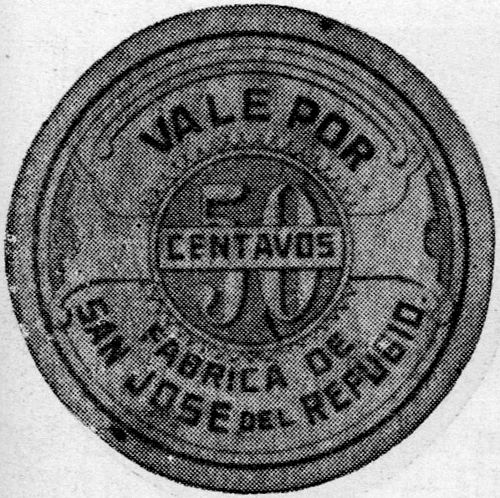
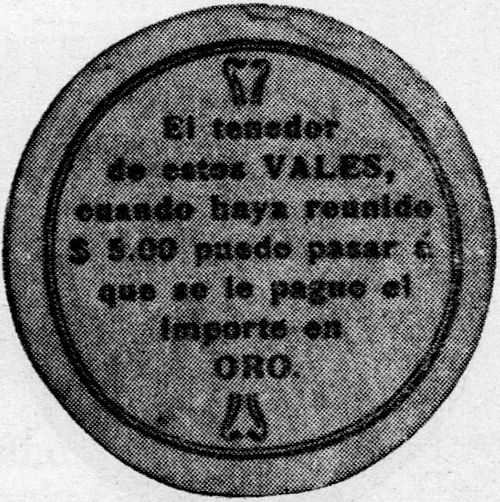 M2716 50c Fábrica de San José del Refugio
M2716 50c Fábrica de San José del Refugio
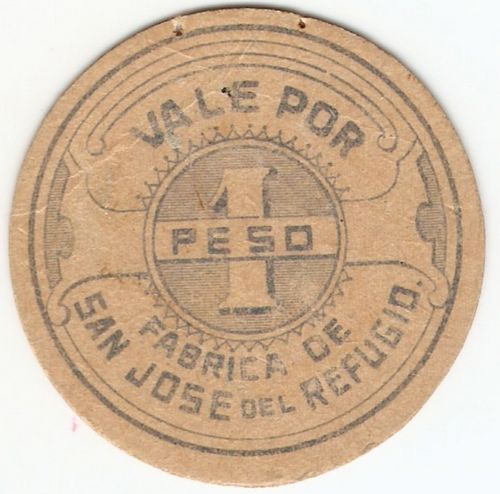 M2717 $1c Fábrica de San José del Refugio
M2717 $1c Fábrica de San José del Refugio
These cartones were produced by J. M. Iguíniz.
Atotonilco el Alto
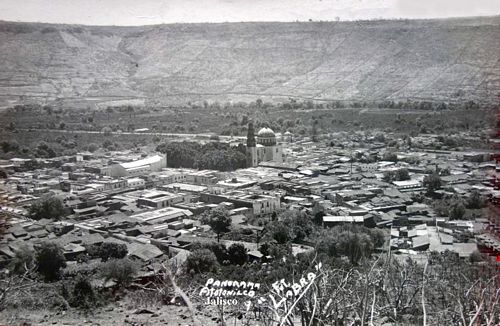
Atotonilco el Alto is about 100 kilometres east of Guadalajara. Various notes for local circulation seem to have been issued as a communal effort, with one entitled "Comercio y Agricultura", which ties up with Lorenzo Valle Valle (see below).
Comercio y Agricultura
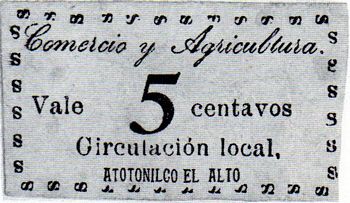 M2397 5c Comercio y Agricultura
M2397 5c Comercio y Agricultura
Series 1
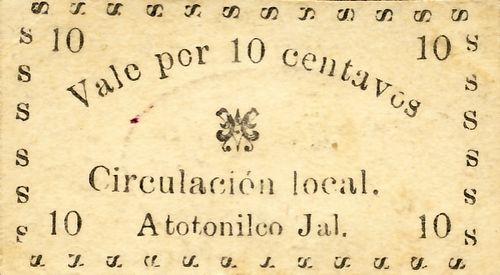
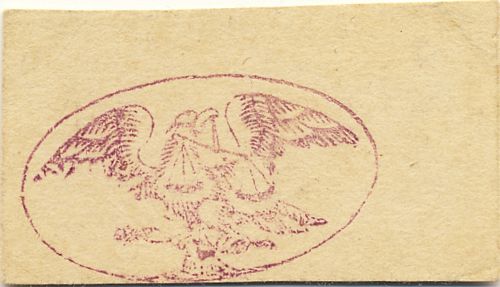 M2395 10c Circulación local
M2395 10c Circulación local
Series 2
A 5c cartón and a 10c, of similar design but without the legend.
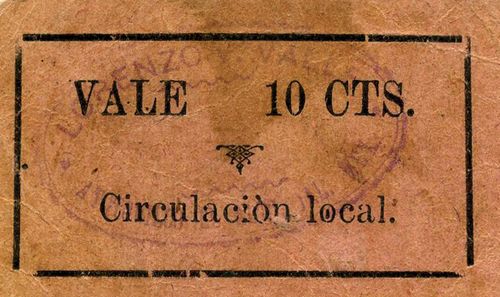 M2398 10c Circulación local
M2398 10c Circulación local
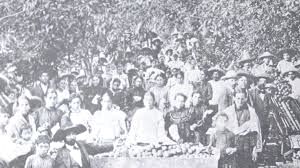
Lorenzo Valle's workforce
This 10c has a handstamp of LORENZO VALLE. Lorenzo Valle Valle came from San José de la Unión and became a leading producer of citrus fruit, a generous and altruistic person who created a lot of employment. He was known throughout Mexico for his produce, exporting oranges, limes and pickled gherkins packed in wooden barrels. The orchards were looked after by his capataz, Lázaro Romero Cárdenas, who paid out wages (la raya) in the portal de Florencio Luna González. Lorenzo Valle Valle lived at portal Luna number 27 (today calle Andrés Terán). He died on 29 January 1968 at the age of 77El Informador, Año LI, Tomo CVCIV, Núm. 17,911, 9 February 1968.
Autlán
Autlán is 190 kilometres south-west of Guadalajara.
The first reference in the Autlán archives to a private issue is on 25 May 1915 when the Presidente Municipal wrote to Riveros Hermanos, in Ayuquila, that he had learnt that they were demanding payment for maiz in fichas that some local businesses has issuedAHMAut, Caja 302, Exp. Sección Ayuntamiento (Sección 8) 2/2, 1915.
The Carrancistas, under General Pablo Quiroga, took possession of Autlán on 25 November 1915. On the same day they appointed Higinio García Meza as Presidente Municipal and at a meeting of businessmen, resolved to address the problem of the lack of small change caused by the withdrawal of the Brigada Moreno notes by authorising certain businesses to issued bonos ó vales, validated by the seal of the Presidente Municipal. These vales would circulate until Carranza’s own fractional currency arrived, at which time each business would collect and reimburse all the vales it had issued, Finally, the agreement noted that vales that had already been issued by businesses would be withdrawn and changed for vales of the new issue AHMAut, Sección Presidencia Municipal (Sección 9), 1915) and (AHMAut, Sección Gobernación (Sección 6), 1915).
So this was not the first time that private notes appeared.
Twenty-nine people signed this agreement, though we know of only a couple of issues. These are a 1c and 10c note for the cigarette factory, “El Vesubio”, that was owned by Higinio García Meza and located on the corner of calle Guillermo Prieto and calle de Reforma, and (if rightly placed here) a 10c from Clemente González é hijo.
“El Vesubio” Fábrica de Cigarros
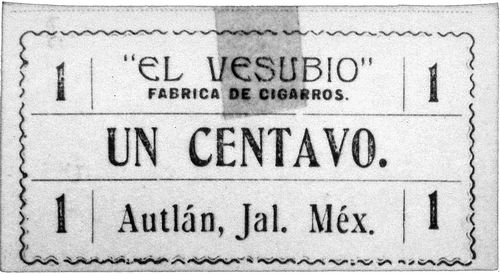 M2415 1c El Vesubio
M2415 1c El Vesubio
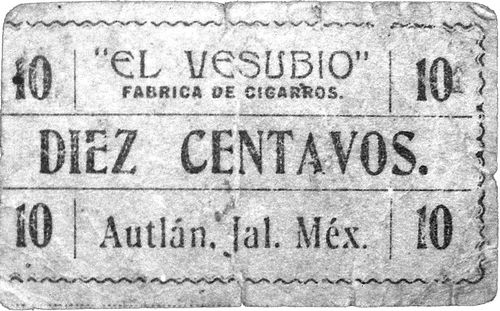 M2416 10c El Vesubio
M2416 10c El Vesubio
We know of black on cream notes, hand signed on the reverse, in at least two values.
Clemente González e hijo
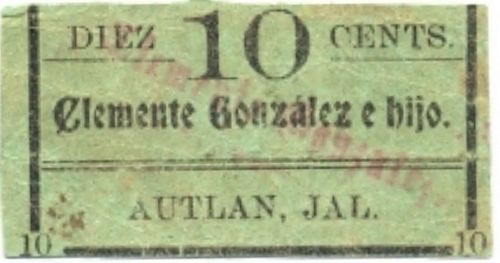
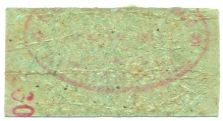
A 10c note.
Clemente González is listed as running a soap factory in 1904Directorio general de la República Mexicana, 1903-1904. On 21 May 1905 he was appointed by the Ayuntamiento to a three-man comission to oversee the construction of a market. By 1915 Clemente and his son were running "La Reforma".
Leónides E. Sánchez
However, on 6 December Leónides E. Sánchez, owner of the appropriately-named “Las Termopilas” on the corner of calle Ramón Corona and calle Mariano Escobedo, sent $364 in 50c and $1 fichas to be stamped by the Presidencia Municipal and stated that he had already issued $152 in fichasAHMAut, Caja 302, Exp. Sección Ayuntamiento (Sección 8) 2/2, 1915.
"Vale del Comercio"
Next, a meeting called by the Comandante de la Plaza, Teniente coronel Antonio L. Cano, on 9 December 1915 addressed the continuing problem by authorising a commission composed of Silvestre Arias, Florencio Topete, Irineo Barragán and Maximo González to print $5.000 in “Vales de Comercio" in four values ((5c yellow, 10c[image needed], 20c yellow and 50c green).
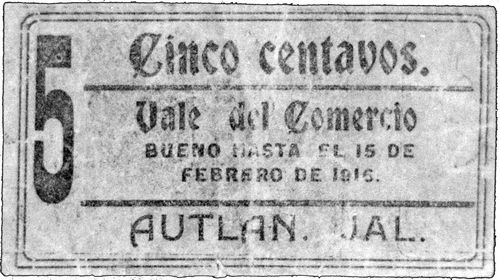 M2410 5c Vale del Comercio
M2410 5c Vale del Comercio
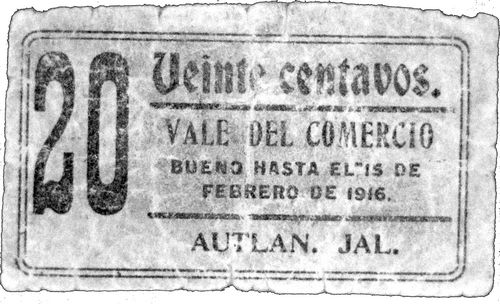 M2412 20c Vale del Comercio
M2412 20c Vale del Comercio
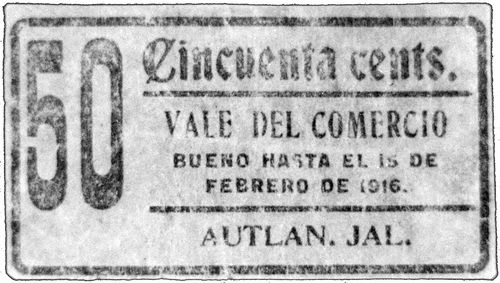 M2413 50c Vale del Comercio
M2413 50c Vale del Comercio
These would again be stamped by the Presidencia Municipal and then distributed among 22 businesses, who would guarantee their notes for the initial period of two months (to be extended, if necessary)ibid..
On 16 December another meeting decided it would now issue $8,000 in notes. After two months, from 16 February 1916, the notes would be redeemed in three casas de comercio: José María Topete’s “La Palestina”, Clemente González e hijo’s “La Reforma” and Adela Blake Vda. de Barragán’s “La Esmeralda”, and destroyed on 1 Marchibid.. Notice of this accord was published in the neighbouring Unión de TulaAHMAut, Sección Presidencia Municipal (Sección 9), 1915.
These notes were printed on the presses of Francisco L. Araiza.
By 30 December the Tesorero de la Junta Monetaria reported that he had received $8,151.60 in “Vales del Comercio”, from the Presidencia Municipal to be distributed to businessesAHMAut, Sección Hacienda (Sección 2), 1915.
On 1 May the Presidencia Municipal agreed with the Comisión to extend the validity of the vales until a new decision of the Presidencia, which would give people 15 days’ notice in which to exchange their notesAHMAut, Sección Presidencia Municipal (Sección 9), 1916.
Ciudad Guzmán
Gran Cantina y Hotel Anguiano
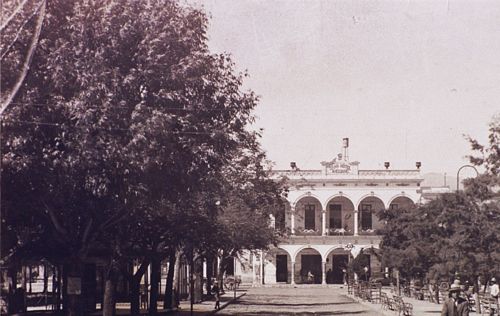
This building, facing the Plaza Principal, was constructed in the 1860s, with a façade in French architectural style, as "Mesón de la Unión". Thirty years later it was called “Hotel de las Bolas de Oro”, referring to the golden spheres that were part of its interior decoration.
On 18 August 1908, when the hotel was acquired by the Anguiano family, the name was changed to "Gran Hotel Anguiano" and a second floor with more rooms added. In 1915 it was owned by Gabriel Anguiano.
In 1947, it was acquired by Evaristo Sánchez Sánchez who renamed it the "Gran Hotel Zapotlán".
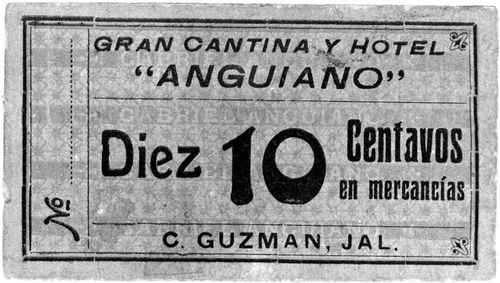 M2429 10c Gran Cantina y Hotel "Anguiano"
M2429 10c Gran Cantina y Hotel "Anguiano"
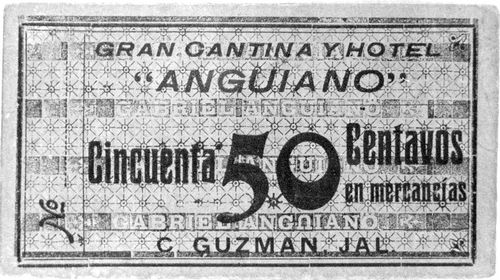 M2450 50c Gran Cantina y Hotel "Anguiano"
M2450 50c Gran Cantina y Hotel "Anguiano"
| from | to | total number |
total value |
||
| 10c | |||||
| 50c |
These blue on white cartones were printed by José María Iguíniz.
Manzano y Compañía
This company was running a grain mill (molino de trigo) in 1903. On 20 April 1915 it was given permission by the Presidente Municipal[text needed] to issue a series of notes, which, because of the lack of revenue stamps, had authorisation from the Administrador Subalterno, J. Ignacio Ochoa, to waive the requirement (Legalizado. - Art. 246 de la Ley del Timbre. C. Guzmán, Jal, Mayo 4 de 1915).
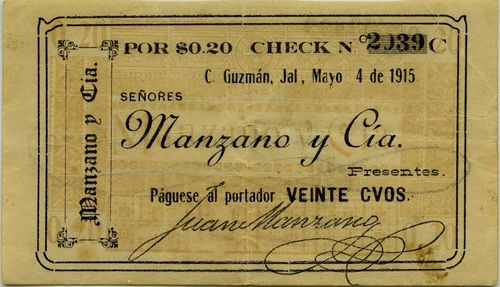
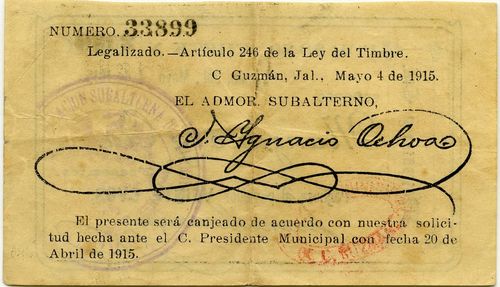 M2452 20c Manzano y Cía.
M2452 20c Manzano y Cía.
| series | from | to | total number |
total value |
||
| 5c | A | |||||
| 10c | B | |||||
| 20c | C | includes numbers 2039 to 2584 |
These notes are signed by Juan Manzano.
|
Juan Manzano |
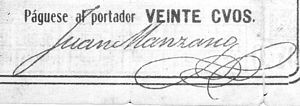 |
Cámara de Comercio
A series of six notes (5c[image needed], 10c[image needed], 20c[image needed], 50c[image needed], $1[image needed] and $2[image needed]), all identical except for the denomination.
Cocula
Cocula is a city located 56 kilometres southwest of Guadalajara.
Compañía de Luz y Fuerza Motriz de Cocula, S. A.
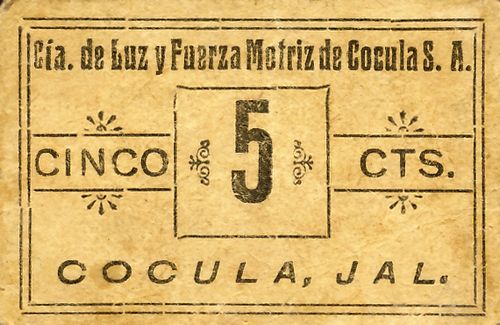
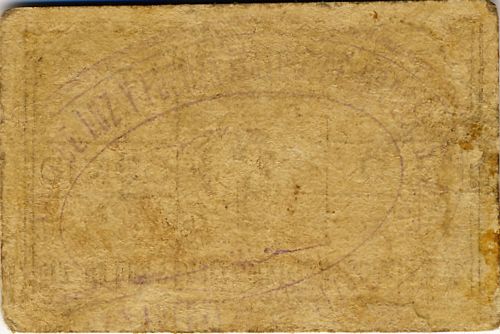 M2441 5c Cía. de Luz y Fuerza Motriz de Cocula
M2441 5c Cía. de Luz y Fuerza Motriz de Cocula
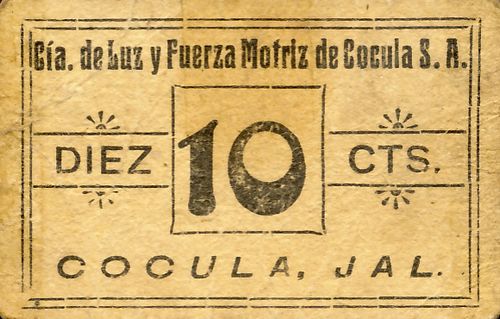 M2442 10c Cía. de Luz y Fuerza Motriz de Cocula
M2442 10c Cía. de Luz y Fuerza Motriz de Cocula
El Grullo
El Grullo is 185 kilometres southwest of Guadalajara and 18 kilometres east of Autlán.
Antonio R. Olivera
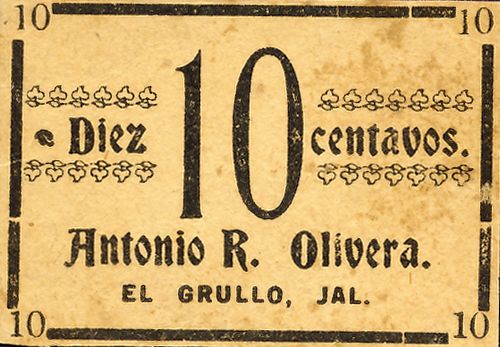
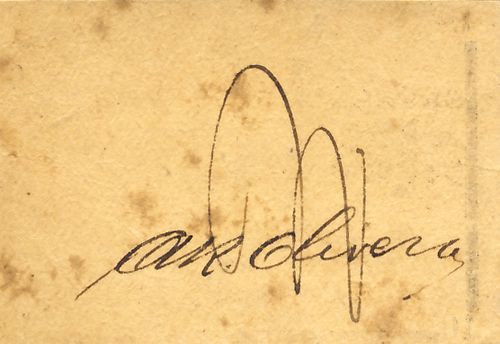 M2463 10c Antonio R. Olivera
M2463 10c Antonio R. Olivera
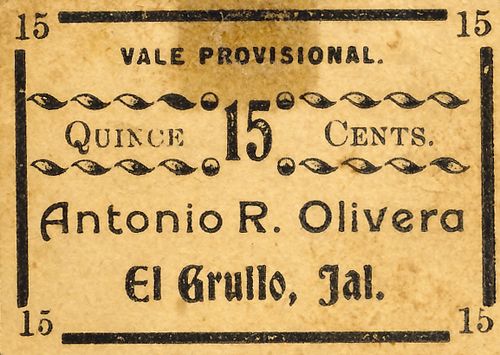
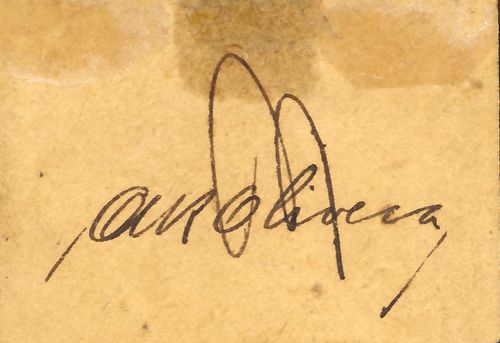 M2464 15c Antonio R. Olivera
M2464 15c Antonio R. Olivera
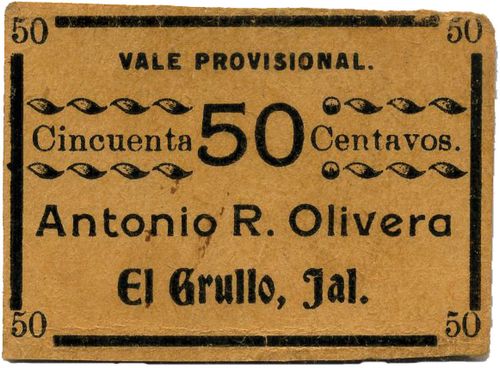 M2465 50c Antonio R. Olivera
M2465 50c Antonio R. Olivera
These might belong to two or three different series as the 10c has no legend and 'Centavos', the 15c has 'VALE PROVISIONAL' and 'CENTS' and the 50c has "VALE PROVISIONAL" and "Centavos". These are signed on the reverse by Antonio R. Olivera.
| Antonio R. Olivera | 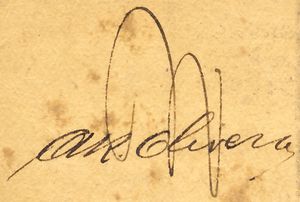 |
These were probably produced by Salvador Araiza, a printer in Unión de Tula, who owned the region’s sole printshopAHMAut, Sección Gobernación (Sección 6), 1915.
La Reforma Mercantil
A cheque issued by Juan Vargas y Compañía of "La Reforma Mercantil".
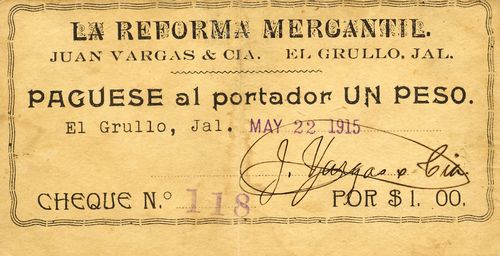
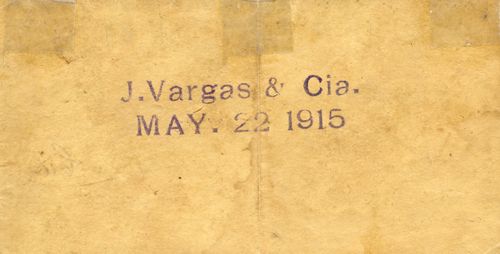 M2467 $1 La Reforma Mercantil
M2467 $1 La Reforma Mercantil
| date on note | from | to | total number |
total value |
||
| $1 | 22 May 1915 | includes number 118 |
Inocencio R. Preciado
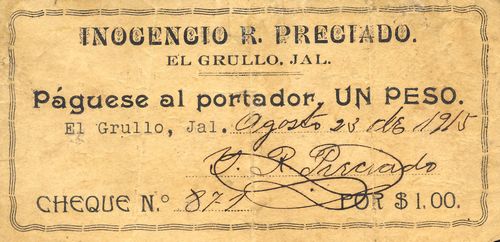
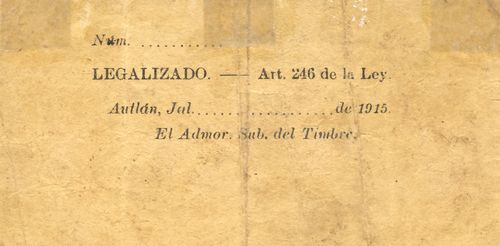 M2462 $1 Inocencio R. Preciado
M2462 $1 Inocencio R. Preciado
| date on note | from | to | total number |
total value |
||
| $1 | 23 August 1915 | includes number 871 |
This was signed by Inocencio R. Preciado.
| Inocencio R. Preciado |  |
These are similar to the former issue but now they have the facility to be certified by the Administrador Subalterno del Timbre in Autlán as having paid the required stamp duty.
El Limón
El Limón is 50 kilometres east of Autlán.
Juan Jiménez
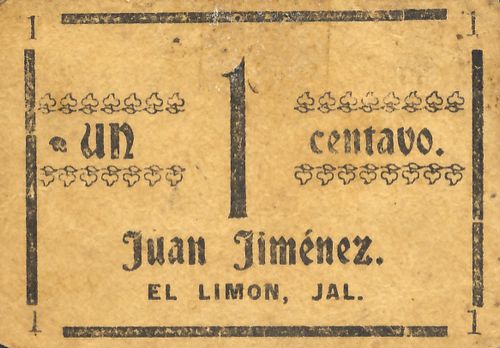
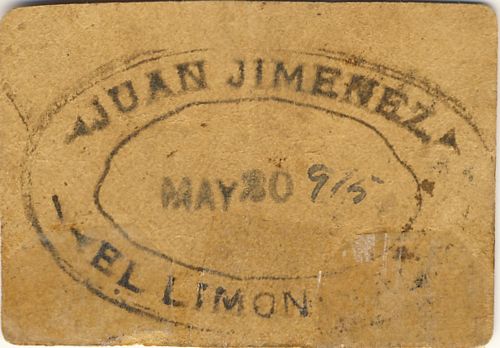 M2469 1c Juan Jiménez
M2469 1c Juan Jiménez
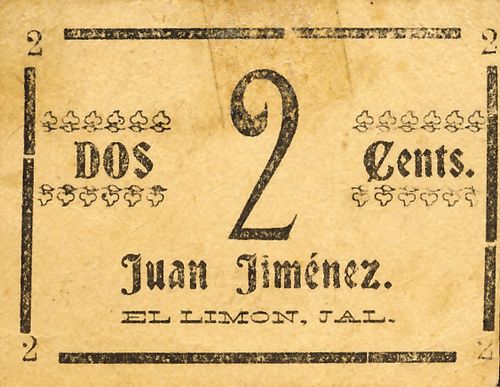
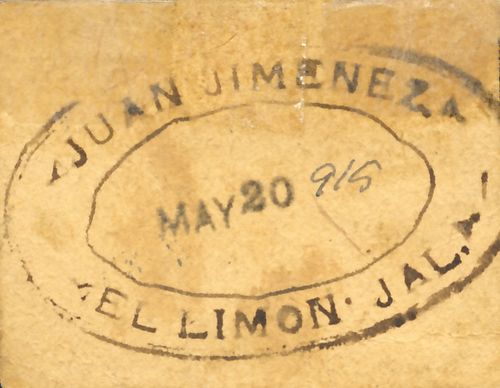 M2470 2c Juan Jiménez
M2470 2c Juan Jiménez
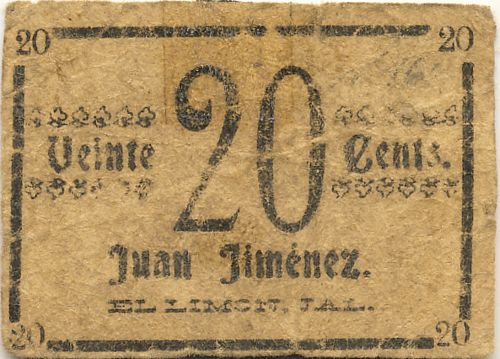
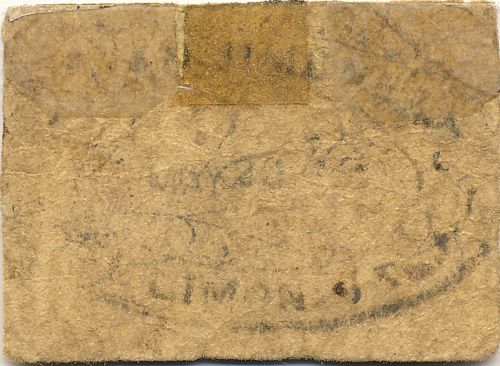 M2471 20c Juan Jiménez
M2471 20c Juan Jiménez
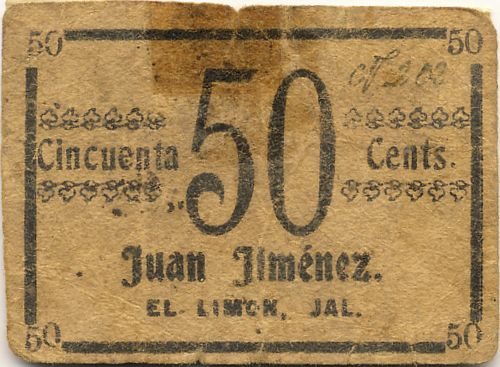
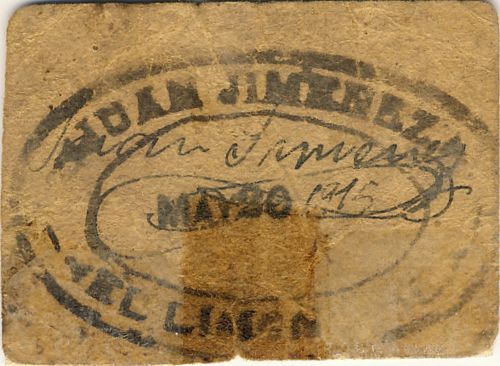 M2472 50c Juan Jiménez
M2472 50c Juan Jiménez
| date on note | from | to | total number |
total value |
||
| 1c | 20 May 1915 |
|||||
| 2c | ||||||
| 20c | includes number 16[ ] | |||||
| 50c | includes number 202 |
Etzatlán
Etzatlán is 90 kilometres west of Guadalajara.
Señoritas Tomasa Romero y Hermana
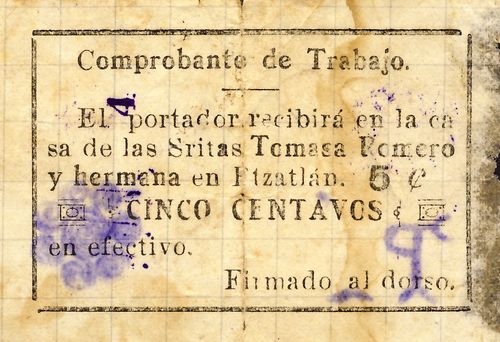
 M2480 5c Tomasa Romero y hermana
M2480 5c Tomasa Romero y hermana
Tomasa Romero owned a farm in Etzatlán and so was sent a census form by the Comisión Local Agraria in January 1923AHME, Sección Gobierno, Serie Agricultura, Año 1923, exp. 51, f3. This note is a "proof of work done" to be redeemed in the Romero sisters' casa in Etzatlán. Once we have recognised the signatory, J. A. Romero, or the branding mark we can probably moved this to the "Haciendas" listing.
| J. A. Romero |  |
Crescenciano M. Romero
 M2495 5c Crescenciano M. Romero
M2495 5c Crescenciano M. Romero
 M2496 10c Crescenciano M. Romero
M2496 10c Crescenciano M. Romero
 M2497 205c Crescenciano M. Romero
M2497 205c Crescenciano M. Romero
| from | to | total number |
total value |
||
| 5c | includes number 191 | ||||
| 10c | includes number 125 | ||||
| 20c | includes number 60 |
Crescenciano M. Romero (identified by his signature on the face of his notesAHME, Sección Gobierno/Directoria, Serie Comercio, Año 1913, exp. 446) was a local businessman and dignitary. He is mentioned with other businessmen in various oficial documents and in both July 1913AHME, Sección Gobierno/Directoria, Serie Fiestas y diversiones públicas, Año 1913, exp. 454, f3 and August 1916AHME, Sección Gobierno, Serie Fiestas y diversiones públicas, Año 1916, exp. 363, f2 was nominated as a member of that year’s Junta Patriótica to organise the program of festivities to celebrate national Independence.
In July 1917 Romero registered that he had established a grocery store called “La Central” at calle de Independencia 53AHME, Sección Hacienda, Serie Tesorería Municipal, Año 1917, exp. 16, f86 though this was probably an annual registration of his existing business.
Ysmael Rubio
 M2499 20c Ysmael Rubio
M2499 20c Ysmael Rubio
| series | from | to | total number |
total value |
||
| 20c | E | includes number 5 |
Ysmael Rubio was a local businessman. He is mentioned with other businessmen in various documents and in August 1916AHME, Sección Gobierno, Serie Fiestas y diversiones públicas, Año 1916, exp. 363, f2 was nominated as a member of that year’s Junta Patriótica to organise the program of festivities to celebrate national Independence.
We know of a 20c cartón.
